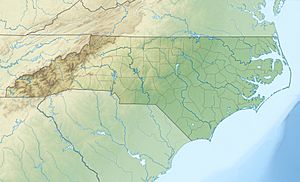Buies Creek facts for kids
Quick facts for kids Buies Creek |
|
|---|---|
|
Location of Buies Creek Creek mouth
|
|
| Other name(s) | Tributary to Cape Fear River |
| Country | United States |
| State | North Carolina |
| County | Harnett |
| City | Buies Creek |
| Physical characteristics | |
| Main source | Black River divide about 1.5 miles southeast of Angier, North Carolina 302 ft (92 m) 35°28′37″N 078°42′47″W / 35.47694°N 78.71306°W |
| River mouth | Cape Fear River about 1 mile southwest of Buies Creek, North Carolina 98 ft (30 m) 35°23′00″N 078°45′13″W / 35.38333°N 78.75361°W |
| Length | 7.31 mi (11.76 km) |
| Basin features | |
| Progression | generally south |
| River system | Cape Fear River |
| Basin size | 27.91 square miles (72.3 km2) |
| Tributaries |
|
| Bridges | NC 55, Butts Road, Sheriff Johnson Road, US 421-NC 27 |
Buies Creek is a small stream, or creek, located in Harnett County, North Carolina. It flows for about 7.31 mi (11.76 km) before joining a much larger river. This creek is an important part of the local water system.
What is Buies Creek?
Buies Creek is known as a "3rd order tributary." This means it's a stream that flows into another stream, which then flows into an even larger stream or river. In this case, Buies Creek flows into the Cape Fear River. It helps carry water from the land into this bigger river.
Where Does Buies Creek Flow?
The journey of Buies Creek begins about 1.5 miles southeast of a town called Angier, North Carolina. From there, the creek generally flows south. It continues its path until it meets the Cape Fear River. This meeting point is about 1 mile southwest of the town of Buies Creek, North Carolina.
The Land Around the Creek
The area that Buies Creek collects water from is called its watershed. The Buies Creek watershed covers about 27.91 square miles (72.3 km2) of land. This means all the rain that falls on this area eventually flows into Buies Creek.
The watershed gets a good amount of rain each year, about 46.7 inches. A significant part of this land, about 22%, is covered by forests. These forests are important because they help keep the water clean and provide homes for many animals.



